Physical Address
304 North Cardinal St.
Dorchester Center, MA 02124
This chapter will cover two groups of tumors thought to recapitulate features of normal perivascular myoid cells, the myopericytoma family and the glomus tumor family. Although thought at one time to be related, recent molecular genetic evidence suggests different pathogenesis for myopericytic and glomus tumors. Nonetheless, there is morphologic overlap between members of these families, and their discrimination may at times be subjective. Tumor of so-called “perivascular epithelioid cells,” the PEComas, will also be covered in this chapter, although these tumors are unrelated to normal perivascular myoid cells, and likely do not have a normal cellular counterpart.
The myopericytoma family of tumors encompasses a group of histologically overlapping lesions, which span a spectrum from “ infantile hemangiopericytoma ” (now felt to represent the cellular phase of myofibroma in young children), to classical myofibroma / myofibromatosis in children and in adult s , and to somewhat more glomoid-appearing lesions, termed myopericytoma and glomangiopericytoma. The distinction between some of these entities can at times be rather subjective, and is generally not of great significance, given their similar morphologic, genetic, and clinical features. However, documentation of multifocal or familial disease is important.
Myofibromas are most often subcutaneous, but can arise in skin, mucosa, or rarely in deep anatomic locations including bone. The most common site of involvement is the head and neck, followed by lower extremities. Lesions may be either solitary (in adults and children) or multiple (infantile myofibromatosis). Myofibromas in children are approximately twice as common in males as they are in females. Myopericytomas and glomangiopericytomas occur most often in adults, without a sex predilection. Myopericytomas present as painless masses, most often of the distal extremities, although any location may be involved, and are usually cutaneous or subcutaneous. Rare intravascular myopericytomas have been reported. The multiple lesions of infantile myofibromatosis typically arise in the first year of life and can involve essentially any anatomic site, from skin, through subcutis and deep anatomic sites including viscera and bone. Rare cases are either congenital or develop later in childhood.
Myofibromas and myopericytomas appear grossly as nonspecific soft tissue masses. Central necrosis and calcification may be apparent in myofibroma and infantile myofibromatosis.
Myofibromas are distinctly zonated lesions, with peripheral hyalinized, distinctly myoid-appearing areas surrounding a central core of smaller, pericyte-like primitive appearing cells ( Fig. 8.1A–C ). The primitive cells are ovoid to spindled with less cytoplasm than the myoid component, whereas the cells in the peripheral zone are spindled with tapered nuclei and grow in fascicles or in a whorled pattern. The cytoplasm and stroma may have a basophilic, pseudo-chondroid appearance in the peripheral/myoid areas ( Fig. 8.1C ). The central zone of myofibroma may be highly cellular, mitotically active and may show necrosis, features that may suggest a sarcoma if one does not identify the better differentiated myoid zones. A branching, staghorn vascular pattern is frequently present in the central zone. Tumors previously referred to as “infantile hemangiopericytoma” represent cellular myofibromas consisting entirely or almost entirely of this central zone, often with necrosis and calcification ( Figs 8.1D and 8.2A ). Myofibromas in adults often show a “reversed” pattern of zonation, with a central rather than peripheral myoid zone, or may show a disorganized admixture of myoid and primitive-appearing areas ( Fig. 8.1B ). There is usually proportionately more of a myoid component than a primitive component in adult cases. All myofibromas may show extension into small blood vessels at the periphery of the lesion ( Fig. 8.2B–C ). Calcifications may be present. A rare, distinctive subset of myofibromas shows high cellularity, a fascicular growth pattern, and only scattered small myoid nodules, and may easily be mistaken for a spindle cell sarcoma ( Fig. 8.3A–B ). These tumors often harbor SRF-RELA fusions.
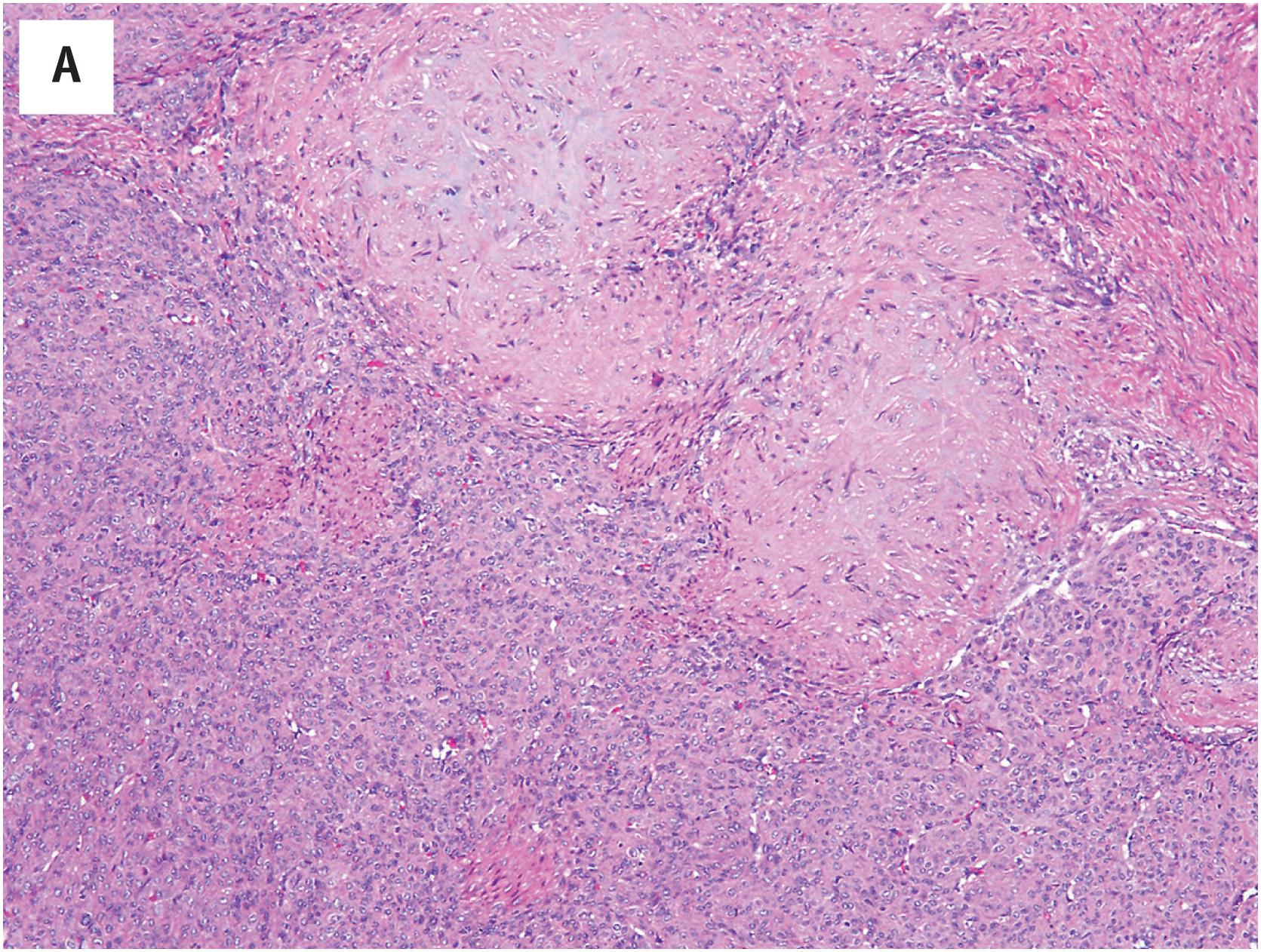
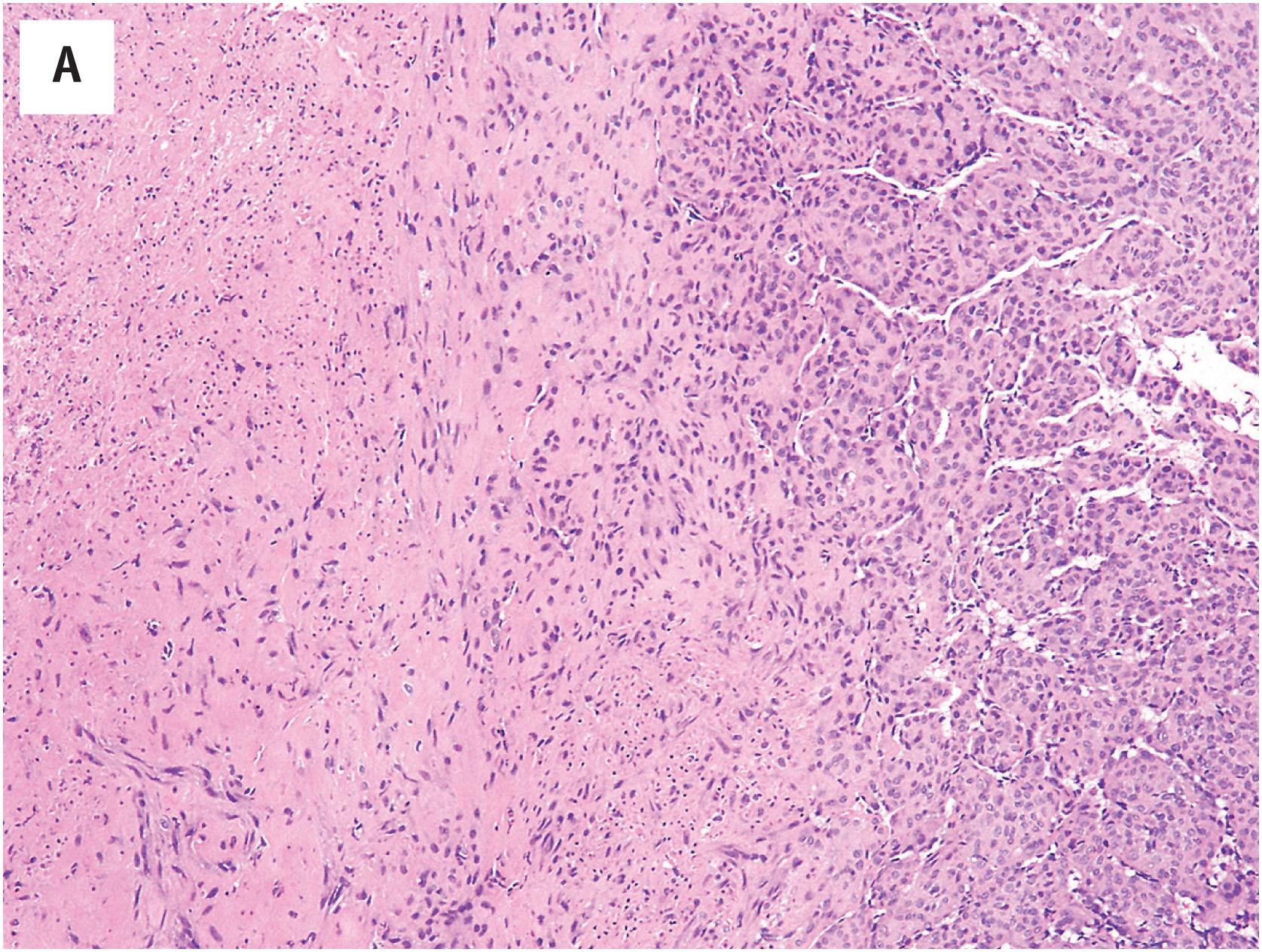
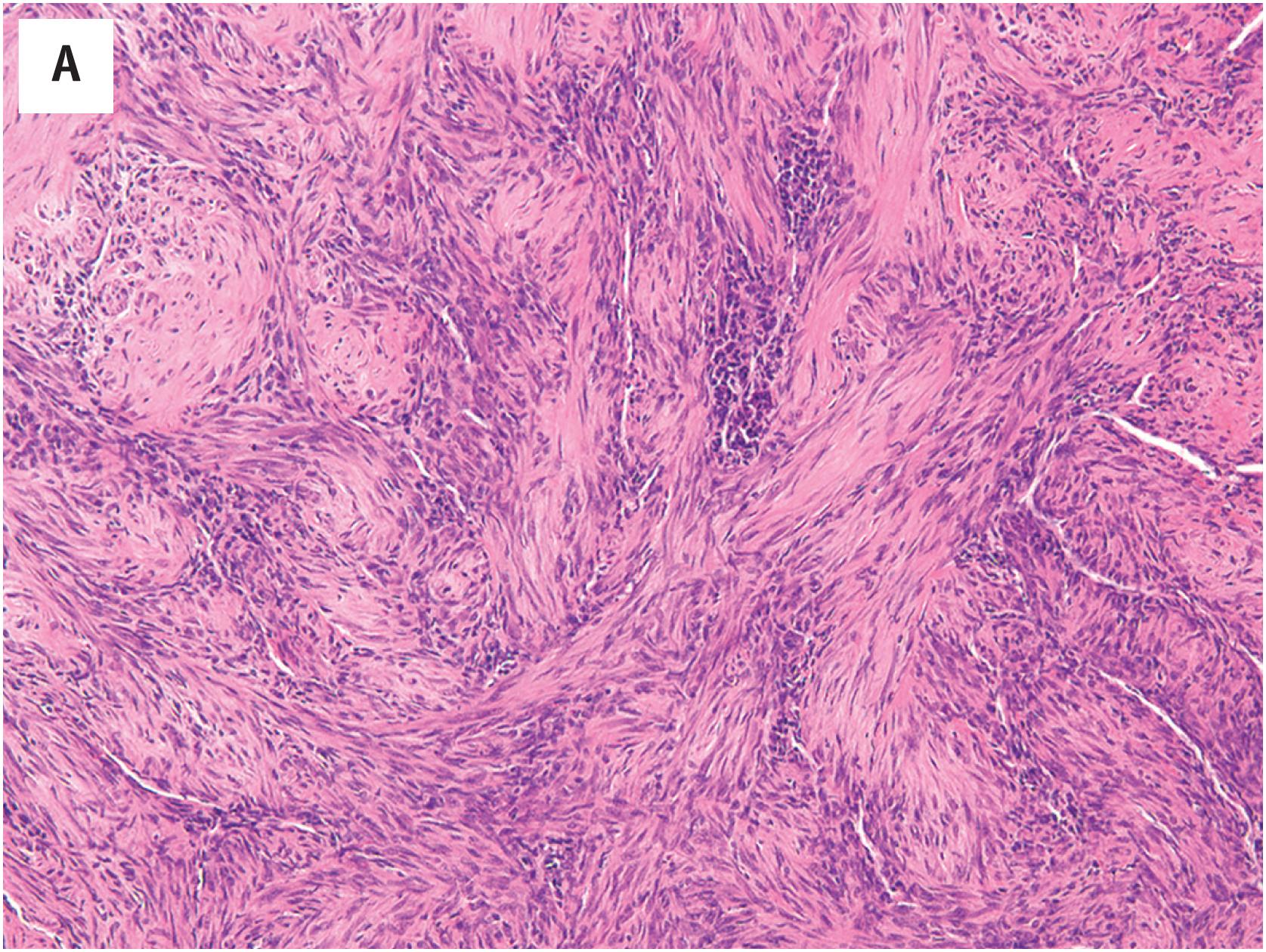
Myopericytoma and glomangiopericytoma are best thought of as lesions that have hybrid features somewhere between myofibroma and glomus tumor. These lesions are typically composed of distinctly myoid-appearing, short, eosinophilic, spindled cells, which are arranged around a branching, staghorn vasculature; the vessels may be thin- or thick-walled ( Fig. 8.4A–C ). Lesional cells may be seen around vessels outside of the main tumoral mass. Myoid balls, reminiscent of the myoid zones in myofibroma, are often present, as are distinctive areas of concentric perivascular growth ( Fig. 8.4D ). In some cases, the cells are more glomoid (corresponding to glomangiopericytoma ), and the histologic features of these cases overlap significantly with those of glomus tumors showing smooth muscle differentiation, so-called glomangiomyoma.
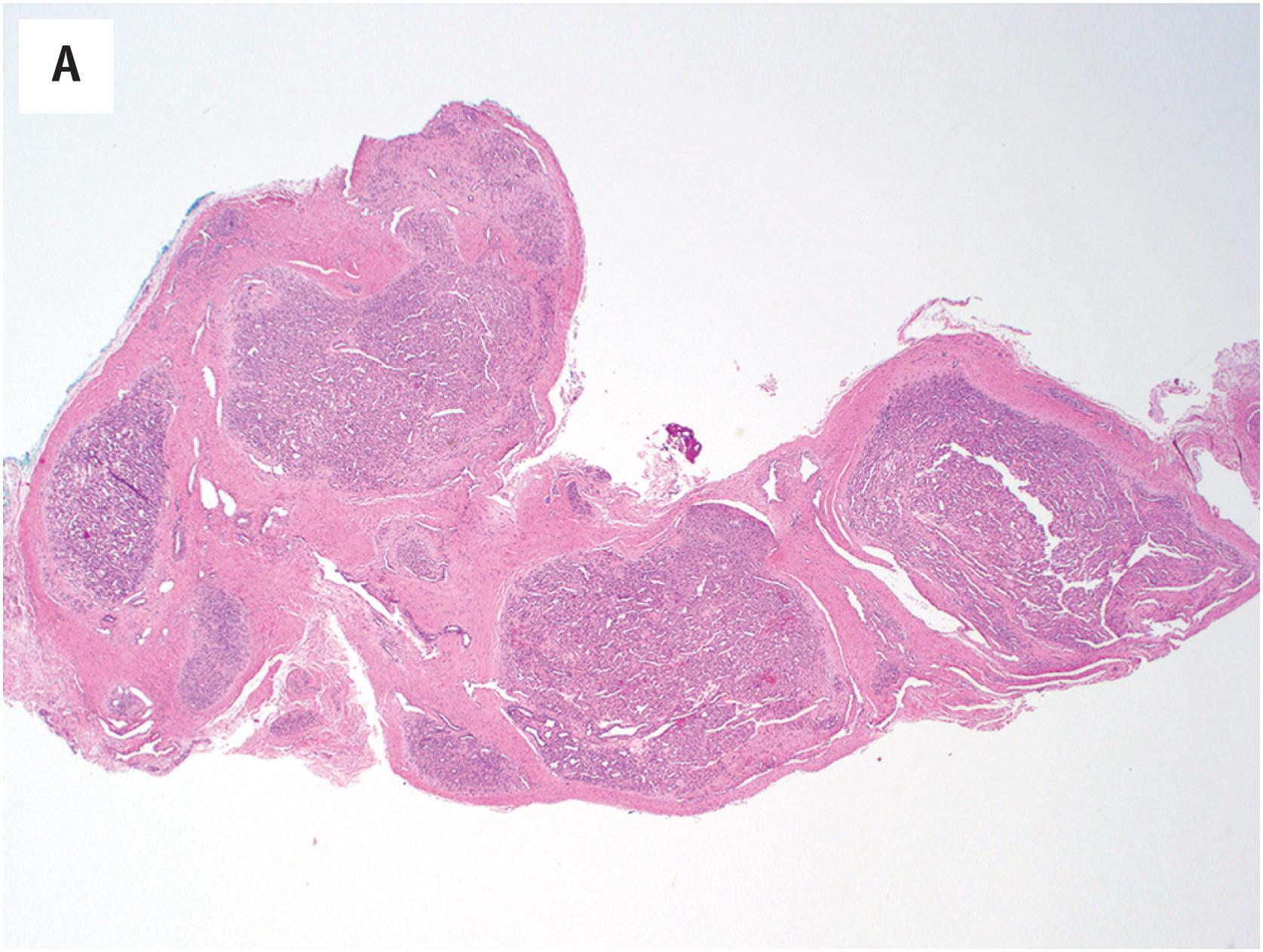
A small number of myopericytomas have been reported to show histologic features of malignancy, including cytological atypia, high mitotic activity, and aggressive invasion of surrounding tissues ( Fig. 8.5A ). The histologic features of such lesions, which may be referred to as malignant myopericytoma, overlap with those of malignant glomus tumors. Exceptionally rare patients present with numerous (sometimes dozens) of discrete, benign-appearing myopericytomas involving a limb, so-called “myopericytomatosis” ( Fig. 8.5B ).
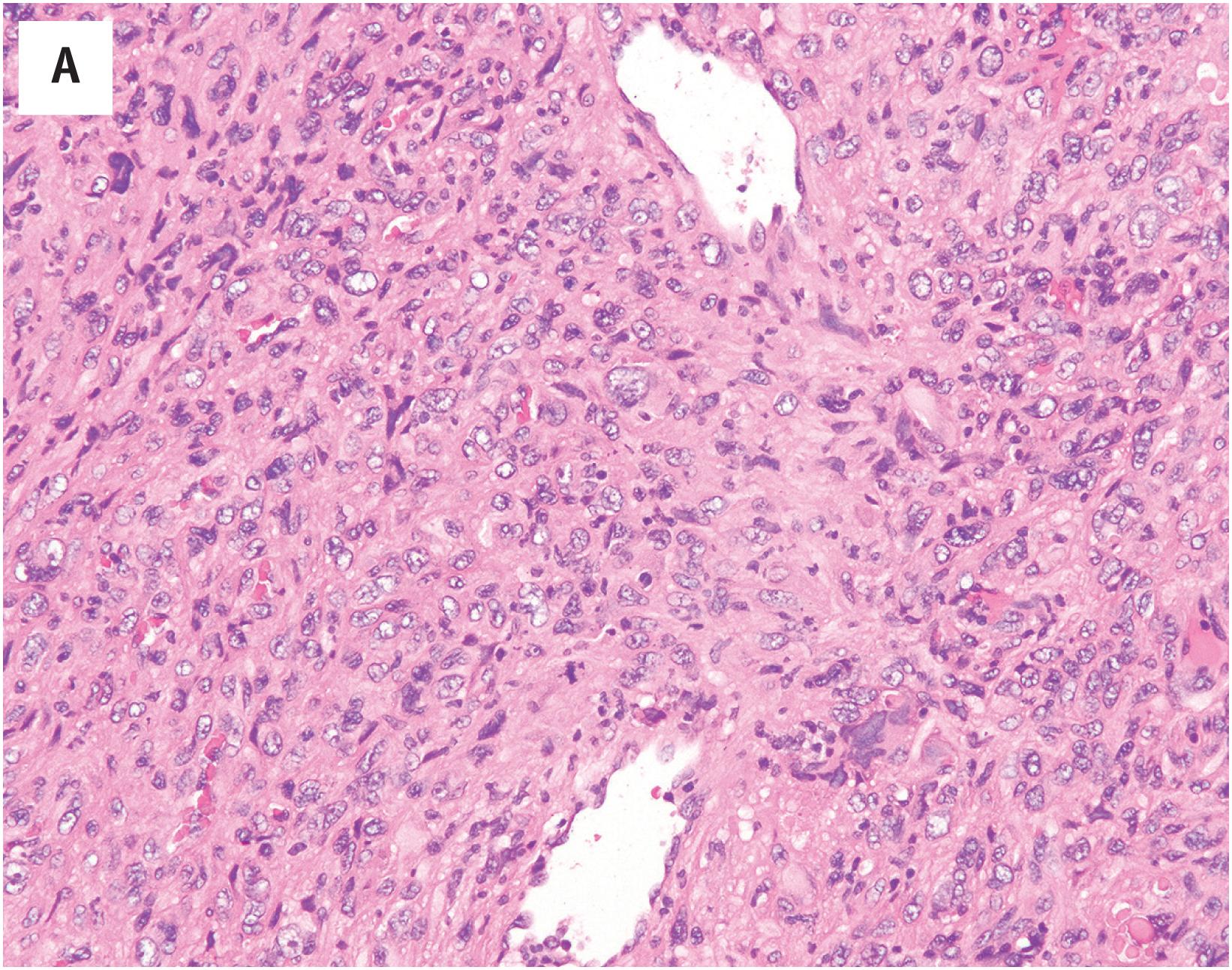
The peripheral, more myoid appearing, zone of myofibromas and all tumor cells of myopericytoma and glomangiopericytoma are strongly positive for smooth muscle actin ( Fig. 8.1E ) and may also show variable degrees of expression of caldesmon. Desmin is rarely expressed by the tumor cells. The central primitive zone of myofibromas shows less expression of smooth muscle actin. CD34 and S100 protein are negative in tumor cells.
Usually benign tumors of pericytes, with morphologic overlap with glomus tumors
Uncommon; myofibroma/myofibromatosis is the most common form, particularly in children
May arise at any cutaneous, soft tissue, bone, or visceral location
Solitary myofibromas and almost all myopericytomas are benign
Multicentric myofibromatosis with visceral involvement results in death in 75% of affected infants
Myofibromas in children are twice as common in male as in female individuals
Adult myofibromas and myopericytomas occur at any age, without a sex predilection
Solitary myofibroma and myopericytoma: small, solitary lesion usually in the skin or subcutis of head and neck or distal extremities
Multicentric myofibromatosis: multiple small lesions in skin, soft tissue, bone, viscera
Excellent prognosis for solitary myofibroma and myopericytoma; cured with simple excision
Solitary myofibromas in children may spontaneously regress
Extremely rare malignant myopericytomas may show aggressive local growth
Multicentric myofibromas in infants with visceral involvement cause death from respiratory or gastrointestinal causes in 75% of cases; low-dose chemotherapy may be of benefit
Central necrosis and calcification may be apparent within otherwise grossly non-specific masses
Myofibroma: peripheral hyalinized zone composed of myoid-appearing spindled cells, often with a pseudo-chondroid appearance; central zone of primitive-appearing round to short spindled cells with hemangiopericytomatous vasculature, calcifications, and necrosis
Adult myofibromas may show inverted or disorganized zonation
Highly cellular myofibromas in infants may be composed almost entirely of the primitive ovoid cells seen in the central zone of myofibroma, with only minimal spindling
Myopericytoma: myoid-appearing, short, spindled cells arranged concentrically around small blood vessels often with a hemangiopericytomatous pattern; glomus-like areas (glomangiopericytoma) may be present
Usually diffuse expression of smooth muscle actin; negative for desmin and CD34; central zone of myofibroma is less frequently positive for actin
Recurrent PDGFRB mutations are frequent in both sporadic and familial forms of myofibroma/myopericytoma
SRF-RELA fusion gene in cellular myofibroma
Glomus tumors, solitary fibrous tumor, other round cell sarcomas and spindle cell sarcomas (malignant glomus tumors)
PDGFRB mutations are key driver events in myopericytoma and myofibroma and are present in at least 70% of sporadic cases, as well as in familial cases. As noted above, highly cellular myofibromas frequently harbor the SRF-RELA fusion gene.
Highly cellular myofibromas, particular those previously labeled “infantile hemangiopericytoma,” may be mistaken for other primitive sarcomas, in particular infantile fibrosarcoma. Although infantile fibrosarcoma may show a branching, staghorn vascular pattern, it is composed of more spindled, cytologically atypical cells, often with numerous interspersed lymphocytes. Molecular evaluation for the ETV-NTRK6 fusion gene may be helpful in excluding infantile fibrosarcoma in difficult cases. In general, careful inspection of highly cellular myofibromas will reveal small peripheral zones of bland, myoid-appearing cells. Myopericytomas may closely resemble angioleiomyomas, although they tend to lack the distinctive thick-walled blood vessels seen in the latter lesion and are composed, in part, of smaller, more glomoid-appearing cells. The distinction between these two benign lesions may, at times, be arbitrary. Similarly, the distinction between myopericytomas with only small areas of spindled growth and glomus tumors that show smooth muscle differentiation (glomangiomyoma) may be difficult, if not impossible. Cellular myofibroma may resemble low-grade leiomyosarcoma, but unlike the latter tumor tends to lack significant desmin expression and usually does not show the same degree of cytoplasmic eosinophilia or blunt-ended nuclear shape. Molecular genetics may aid distinction between the two, with identification of the SRF-RELA fusion gene in cellular myofibroma.
Solitary fibrous tumor shows a similar branching vascular pattern, but the spindled cells are arranged in a haphazard pattern, appear less myoid, and lack the concentric arrangement around vessels typical of myopericytoma. Immunohistochemistry can readily distinguish the two, as SFT shows expression of CD34 and STAT6 and is typically actin-negative.
Solitary myofibromas and multiple myofibromas confined to soft tissue and bone have an excellent prognosis, with many lesions regressing spontaneously and others requiring little more than simple excision. Infants with multiple visceral myofibromas have a much more guarded prognosis, with death from respiratory or gastrointestinal causes in up to 75% of affected patients. Low-dose chemotherapy has shown some value in the treatment of infants with multiple visceral myofibromas, and tyrosine-kinase inhibition may be particularly useful for cases with PDGFRB mutations. Solitary (adult) myofibromas are entirely benign and require only simple excision. Most myopericytomas and glomangiopericytomas are histologically and clinically benign and are treated with simple excision. Rare malignant myopericytomas have behaved as low-grade sarcomas, and require more extensive surgery, possibly with adjuvant radiotherapy.
Become a Clinical Tree membership for Full access and enjoy Unlimited articles
If you are a member. Log in here